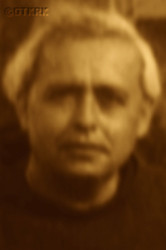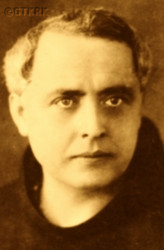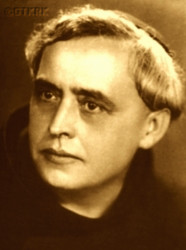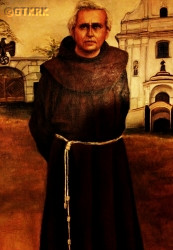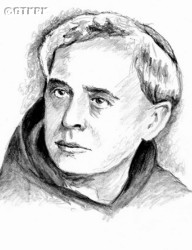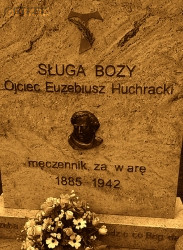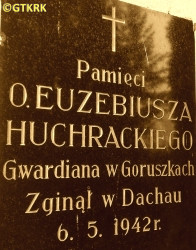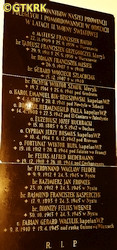Roman Catholic
St Sigismund parish
05-507 Słomczyn
85 Wiślana Str.
Konstancin deanery
Warsaw archdiocese, Poland
full list:
displayClick to display full list

searchClick to search full list by categories
wyświetlKliknij by wyświetlić pełną listę po polsku

szukajKliknij by przeszukać listę wg kategorii po polsku

Martyrology of the clergy — Poland
XX century (1914 – 1989)
personal data
religious status
Servant of God
surname
HUCHRACKI
surname
versions/aliases
CHUCHRACKI
forename(s)
Joseph Victor (pl. Józef Wiktor)
religious forename(s)
Eusebius (pl. Euzebiusz)
function
religious cleric
creed
Latin (Roman Catholic) Church RCmore on
en.wikipedia.org
[access: 2014.09.21]
congregation
Order of Friars Minor OFMmore on
en.wikipedia.org
[access: 2013.05.19]
(i.e. Franciscans, Minorites)
diocese / province
Assumption into Heaven of the Blessed Mary province OFMmore on
pl.wikipedia.org
[access: 2014.08.14]
St Hedwig od Silesia province OFMmore on
pl.wikipedia.org
[access: 2014.08.18]
honorary titles
„Iron Cross” i.e. Germ. „Eisernes Kreuz” (German Empire) — 2nd classmore on
„Iron Cross” i.e. Germ. „Eisernes Kreuz” (German Empire) – 2nd_class
date and place
of death
06.05.1942

KL Dachau ‐ MunichGermany (Bavaria) ‐ Austria
alt. dates and places
of death
11.06.1942 („official” date)
details of death
While studying at a gymnasium in Katowice, became a member of a clandestine Polish youth organization.
When the German school authorities — these were the times of partitions of Poland —– discovered this fact, he was expelled from school. Moved then to Wrocław.
During World War I drafted into German Imperial Army. From 10.1914 served on German eastern (1914‐1916) and western (1916‐1918) fronts, as the chaplain of German 37th Infantry Division, in the rank of mayor — 37th Division, formed in East Prussia, participated in victorious battle with Russians in Tannenberg (1914) and first battle of Mazurian Lakes (1914), next in Gorlice Battle (05.1915), when German–Austrian forces broke through Russian defences, and next in battles on Dzvina river; in 12.1916 Division got transferred to the Western Front and took part in trenches war: participated in German Kaiserschlacht — Spring Offensive of 1915, e.g. in hird Battle of the Aisne, and the last defensive battles the Meuse‐Argonne (till 11.1918).
After German and Russian invasion of Poland in 09.1939 and start of the World War II, after start of German occupation, interned by the Germans on 15.02.1940 in Miejska Górka / Goruszki in his monastery.
From there on 26.04.1941 — after seizure of the monastery on 01.04.1941 by the Germans to use it as prison — transported to IL Lubin transit camp in Lubiń.
Next on 06.10.1941 jailed in KL Posen (Fort VII) concentration camp and on 30.10.1941 transported to KL Dachau concentration camp.
Finally from there — totally exhausted — transported in a so‐called Germ. „Invalidentransport” (Eng. „Invalids' transport”) towards TA Hartheim Euthanasia Center where was to be murdered in a gas chamber.
Did not reach the destination — prob. already in the camp, just before the formation of the Germ. „Invalidentransport” and loading of the victims on the railway siding in KL Dachau onto the freight wagon in which the prisoners were transported, or on the first stage of the journey to the Euthanasia Center TA Hartheim, on the way to Munich, and there thrown out of the wagon and then incinerated in the city crematorium.
According to the death certificate, prepared in KL Dachau, the „honest” otherwise German „medical doctors” and formalists — and at the same time, unrivaled fairy tale spinners — noted that the cause of death was Germ. „Versagen des Kreislaufes bei Herzmuskelentartung” (Eng. „Failure of the circulatory system with diabetic dysentery”).
prisoner camp's numbers
28240Click to display source page (KL DachauClick to display the description)
cause of death
extermination: gassing in a gas chamber
perpetrators
Germans
sites and events
TA HartheimClick to display the description, «Aktion T4»Click to display the description, KL DachauClick to display the description, KL PosenClick to display the description, IL LubinClick to display the description, IL GörchenClick to display the description, Reichsgau WarthelandClick to display the description, Ribbentrop‐MolotovClick to display the description, Pius XI's encyclicalsClick to display the description
date and place
of birth
15.10.1885Birth certification on:
photos.szukajwarchiwach.gov.pl
[access: 2025.08.19]

Katowicetoday: Katowice city pov., Silesia voiv., Poland
more on
en.wikipedia.org
[access: 2021.08.12]
parents
HUCHRACKI Peter
🞲 1847, ? — 🕆 ?, ?

BĄCZKOWSKA Stanislava
🞲 1850, ? — 🕆 ?, ?
religious vows
08.04.1907 (temporary)
16.04.1910 (permanent)
presbyter (holy orders)
ordination
21.06.1913

Wrocławtoday: Wrocław city pov., Lower Silesia voiv., Poland
more on
en.wikipedia.org
[access: 2021.04.02]
positions held
1938 – 1940
guardian — Miejska Górkatoday: part of Karolinki village/district, Miejska Górka gm., Rawicz pov., Greater Poland voiv., Poland
more on
en.wikipedia.org
[access: 2021.12.18] ⋄ Holy Cross monastery („on Goruszki hill”), Franciscans OFM
friar — Osiecznatoday: Osieczna gm., Leszno pov., Greater Poland voiv., Poland
more on
en.wikipedia.org
[access: 2021.07.18] ⋄ St Valentine Priest and Martyr monastery, Franciscans OFM
friar — Pakośćtoday: Pakość gm., Inowrocław pov., Kuyavia‐Pomerania voiv., Poland
more on
en.wikipedia.org
[access: 2021.12.18] ⋄ monastery, Franciscans OFM
friar — Wronkitoday: Wronki gm., Szamotuły pov., Greater Poland voiv., Poland
more on
en.wikipedia.org
[access: 2021.06.20] ⋄ Annunciation to the Blessed Virgin Mary monastery, Franciscans OFM
1936
friar — Wieluńtoday: Wieluń gm., Wieluń pov., Łódź voiv., Poland
more on
en.wikipedia.org
[access: 2021.07.18] ⋄ Annunciation to the Blessed Virgin Mary monastery, Franciscans OFM — parish vicar
1931 – 1932
guardian — Rybniktoday: Rybnik city pov., Silesia voiv., Poland
more on
en.wikipedia.org
[access: 2021.08.12] ⋄ St Joseph the Worker monastery, Franciscans OFM
1929 – 1930
guardian — Rybniktoday: Rybnik city pov., Silesia voiv., Poland
more on
en.wikipedia.org
[access: 2021.08.12] ⋄ St Joseph the Worker monastery, Franciscans OFM
1926 – 1929
guardian — Chocztoday: Chocz gm., Pleszew pov., Greater Poland voiv., Poland
more on
pl.wikipedia.org
[access: 2020.09.18] ⋄ St Michael the Archangel monastery, Franciscans OFM
1923 – 1924
guardian — Chocztoday: Chocz gm., Pleszew pov., Greater Poland voiv., Poland
more on
pl.wikipedia.org
[access: 2020.09.18] ⋄ St Michael the Archangel monastery, Franciscans OFM
1907 – 1913
student — Karłowicetoday: neighborhood in Wrocław, Wrocław city pov., Lower Silesia voiv., Poland
more on
en.wikipedia.org
[access: 2021.04.02] ⋄ philosophy and theology, St Anthony of Padua Higher Theological Seminary („Antonianum”), Franciscans OFM
07.04.1906 – 07.04.1907
novitiate — Borki Wielkietoday: Olesno gm., Olesno pov., Opole voiv., Poland
more on
en.wikipedia.org
[access: 2021.12.18] ⋄ St Francis of Assisi monastery, Franciscans OFM
from 1906
friar — Wrocławtoday: Wrocław city pov., Lower Silesia voiv., Poland
more on
en.wikipedia.org
[access: 2021.04.02] ⋄ monastery, Franciscans OFM — begining of ministry
comments
The urn with ashes — cremation prob. took place in the crematorium at the Germ. Ostfriedhof (Eng. Eastern Cemetery) in Munich — since 1950 has been kept at the Am Perlacher Forst cemetery, in a place known as Germ. Ehrenhain I (Eng. „Remembrance Grove No. 1”), in Munich. In 2013, information about the „disclosure” of the cremated remains of the KL Dachau victims made it to the front pages of news outlets. His urn bears the No. K3909.
others related
in death
GIZOWSKIClick to display biography Edmund, GLISZCZYŃSKIClick to display biography Francis, GŁADYSZClick to display biography Bronislav, GŁOGOWSKIClick to display biography Lawrence, GMEREKClick to display biography Ceslav, GODLEWSKIClick to display biography Julian, GOLĘDZINOWSKIClick to display biography John Ignatius, GOŁĘBIOWSKIClick to display biography Vladislav (Bro. Alex), GOSTYŃSKIClick to display biography Casimir Witold, GOZDEKClick to display biography Adolph Roman, GÓRECKIClick to display biography Joseph (Fr Vladislav), GRABARCZYKClick to display biography James, GRABARCZYKClick to display biography John, GRABAREKClick to display biography Bronislav, GROCHOLSKIClick to display biography Edmund Vladislav, GRODKIEWICZClick to display biography John, GRONWALDClick to display biography Thaddeus Edward, GRYSZKAClick to display biography Thomas, GRZESIEKClick to display biography Francis, GUDERClick to display biography John, GURANOWSKIClick to display biography Sigismund Stanislav, GUTKAClick to display biography Bronislav, HAMERLINGClick to display biography Valentine Casimir, HEINZELClick to display biography Joseph Leopold, HOFMANClick to display biography Francis, JANIAKClick to display biography Steven, JARCZEWSKIClick to display biography John, JARZĘBIŃSKIClick to display biography Dominic Steven Alexander, JARZYNAClick to display biography Arcadius Casimir, JASKULSKIClick to display biography Telesphorus, JAŚKIEWICZClick to display biography Joseph Benedykt, JAWORSKIClick to display biography Thomas, JĘDRYCHOWSKIClick to display biography John, KACZOROWSKIClick to display biography Henry Sigismund, KALINOWSKIClick to display biography Leo, KAMIŃSKIClick to display biography Vaclav (Bro. Steven), KARBOWIAKClick to display biography John, KARCZEWSKIClick to display biography Apollinaris Casimir, KARCZEWSKIClick to display biography Steven, KASIŃSKIClick to display biography Stanislav Lamberto, KATUSZEWSKIClick to display biography Felix, KICIŃSKIClick to display biography John, KISZKURNOClick to display biography Anthony, KOCHANOWICZClick to display biography Bronislav Stanislav, KOCHANOWSKIClick to display biography Vladislav
sites and events
descriptions
TA Hartheim: From 05.1940, in the Germ. Tötungsanstalt (Eng. Killing/Euthanasia Center) TA Hartheim, at the Schloss Hartheim castle in Alkoven in Upper Austria, belonging to KL Mauthausen‐Gusen complex of concentration camps, as part of «Aktion T4» program, the Germans murdered victims — people mentally retarded and disabled — in gas chambers with carbon monoxide. Till 24.08.1941 and the formal end of the «Aktion T4» program, c. 18,000 people were murdered in TA Hartheim. In 04.1941 the program was extended to include concentration camp prisoners. Most, if not all, of the murdered clergy from the KL Dachau concentration camp were taken to TA Hartheim in the so‐called Germ. „Invalidentransport” (Eng. „transport of invalids”), prisoners who were sick and, according to the Germans, „unable to work” (initially under the pretext of transfer to a better camp) — after the formal end of «Aktion T4» as part of the program codenamed «Aktion 14 f 13». It is estimated that at this stage — until 11.12.1944 — c. 12,000 prisoners were gassed at TA Hartheim.
Note: The dates of death of victims murdered in Schloss Hartheim indicated in the „White Book” are the dates of deportations from the last concentration camp the victims where held in. The real dates of death are unknown — apart from c. 49 priests whose names were included in the niem. „Invalidentransports”, but who did not arrive at TA Hartheim. Prob. perished on the day of transport, somewhere between KL Dachau and Munich, and their bodies were thrown out of the transport and cremated in Munich. The investigation conducted by Polish Institute of National Remembrance IPN concluded, that the other victims were murdered immediately upon arrival in Schloss Hartheim, bodies cremated and the ashes spread over local fields and into Danube river. In order to hide details of the genocide Germans falsified both dates of death (for instance those entered into KL Dachau concentration camp books, which are presented in „White Book” as alternative dates of death) and their causes. (more on: ipn.gov.plClick to attempt to display webpage
[access: 2019.05.30], en.wikipedia.orgClick to attempt to display webpage
[access: 2019.05.30])
«Aktion T4»: German state euthanasia program, systematic murder of people mentally retarded, chronically, mentally and neurologically ill — „elimination of live not worth living” (Germ. „Vernichtung von lebensunwertem Leben”). At a peak, in 1940‐1941, c. 70,000 people were murdered, including patients of psychiatric hospitals in German occupied Poland — German formalists noted then that, among others, „performing disinfection [i.e. gassing] of 70,273 people with a life expectancy of up to 10 years saved food in the amount of 141,775,573.80 Deutschmark”. From 04.1941 also mentally ill and „disabled” (i.e. unable to work) prisoners held in German concentration camps were included in the program — denoted then as «Aktion 14 f 13». C. 20,000 inmates were then murdered, including Polish Catholic priests held in KL Dachau concentration camp, who were murdered in Hartheim gas chambers. The other „regional extension” of «Aktion T4» was «Aktion Brandt» program during which Germans murdered chronically ill patients in order to make space for wounded soldiers. It is estimated that at least 30,000 were murdered in this program. (more on: en.wikipedia.orgClick to attempt to display webpage
[access: 2014.10.31])
KL Dachau: KL Dachau in German Bavaria, set up in 1933, became the main German Germ. Konzentrationslager (Eng. concentration camp) KL for Catholic priests and religious during World War II: On c. 09.11.1940, Reichsführer‐SS Heinrich Himmler, head of the SS, Gestapo and German police, as a result of the Vatican's intervention, decided to transfer all clergymen detained in various concentration camps to KL Dachau camp. The first major transports took place on 08.12.1940. In KL Dachau Germans held approx. 3,000 priests, including 1,800 Poles. The priests were forced to slave labor in the Germ. „Die Plantage” — the largest herb garden in Europe, managed by the genocidal SS, consisting of many greenhouses, laboratory buildings and arable land, where experiments with new natural medicines were conducted — for many hours, without breaks, without protective clothing, no food. They slaved in construction, e.g. of camp's crematorium. In the barracks ruled hunger, freezing cold in the winter and suffocating heat during the summer, especially acute in 1941‐1942. Prisoners suffered from bouts of illnesses, including tuberculosis. Many were victims of murderous „medical experiments” — in 11.1942 c. 20 were given phlegmon injections; in 07.1942 to 05.1944 c. 120 were used by for malaria experiments. More than 750 Polish clerics where murdered by the Germans, some brought to TA Hartheim euthanasia centre set up in Schloss Hartheim in Austria and murdered in gas chambers. At its peak KL Dachau concentration camps’ system had nearly 100 slave labour sub‐camps located throughout southern Germany and Austria. There were c. 32,000 documented deaths at the camp, and thousands perished without a trace. C. 10,000 of the 30,000 inmates were found sick at the time of liberation, on 29.04.1945, by the USA troops… (more on: www.kz-gedenkstaette-dachau.deClick to attempt to display webpage
[access: 2013.08.10], en.wikipedia.orgClick to attempt to display webpage
[access: 2016.05.30])
KL Posen: German Posen — Fort VII — camp founded in c. 10.10.1939 in Poznań till mid of 11.1939 operated formally as Germ. Konzentrationslager (Eng. concentration camp) KL Posen, and this term is used throughout the White Book, also later periods. It was first such a concentration camp set up by the Germans on Polish territory — in case of Greater Poland (Wielkopolska) directly incorporated into German Reich. In 10.1939 in KL Posen for the first time Germans used gas to murder civilian population, in particular patients of local psychiatric hospitals. From 11.1939 the camp operated as German political police Gestapo prison and transit camp (Germ. Übergangslager), prior to sending off to concentration camps, such as KL Dachau or KL Auschwitz. In 28.05.1941 the camp was rebranded as police jail and slave labour corrective camp (Germ. Arbeitserziehungslager). At its peak up to 7‐9 executions were carried in the camp per day, there were mass hangings of the prisoners and some of them were led out to be murdered elsewhere, outside of the camp. Altogether in KL Posen Germans exterminated approx. 20,000 inhabitants of Greater Poland (Wielkopolska) region, including many representatives of Polish intelligentsia, patients and staff of psychiatric hospitals and dozen or so Polish priests. Hundreds of priests were held there temporarily prior to transport to other concentration camps, mainly KL Dachau. From 03.1943 the camp had been transformed into an industrial complex (from 25.04.1944 — Telefunken factory manufacturing radios for submarines and aircrafts). (more on: www.wmn.poznan.plClick to attempt to display webpage
[access: 2019.02.02], en.wikipedia.orgClick to attempt to display webpage
[access: 2013.12.27])
IL Lubin: The Gestapo District Office in Poznań issued on 13.12.1939 executive instruction Ref. IIB No. 406/39 Tgb. No. 3045/39, ordering: „Based on the regulation of the Germ. Höherer SS‐ und Polizeiführer (Eng. Higher Commander of the SS and Police) [of the Germ. Warthegau (Eng. Greater Poland)] province of 12.11.1939 [SS‐Gruppenführer Wilhelm Koppe], apart from Poles and Jews, also Catholic clergy will be expelled. Action against this group of people should be carried out in such a way that internment and transport are separate […] C. 80% of Catholic clergy are expected to be expelled. The selection based on political threat posed. Internees cannot be placed in regular transit camps due to the possibility of international protest. Catholic clergy should be interned in men's monasteries and held there till mass transportation out”. And so at the Benedictine abbey in Lubiń near Kościan, at the beginning of 1940, the Germans — Germ. Geheime Staatspolizei (Eng. Secret State Police), i.e. Gestapo — organized an temporary Germ. „Internierungslager” (Eng. „Internment camp”) IL Lubin for priests and friars from Greater Poland (dated from 15.02.1940, although the Germans brought several priests to the abbey earlier). E.g. in 04.1941 Franciscan friars from Goruszki monastery were brought in. In total, 104 clergymen were held in the monastery. On 06.10.1941, as part of the third great operation of arrests of the Polish clergy of Greater Poland — more precisely, from the Germ. Warthegau occupational province — all interned priests were transported to the KL Dachau concentration camp. Religious brothers were allowed to return to their family homes. The monastery was turned into an old people's home, and later as a training center for national‐socialist German youth, Germ. „Hitler‐Jugend” (Eng. „Hitler youth”). Rich library collections and other goods were plundered. The Benedictines returned to the monastery on 25.01.1945, after the German defeat. (more on: www.benedyktyni.netClick to attempt to display webpage
[access: 2013.08.10], pl.wikipedia.orgClick to attempt to display webpage
[access: 2013.08.10])
IL Görchen: The Franciscan monastery „Goruszki” in Miejska Górka, c. 10 km from Rawicz, became a place of internment for Polish priests and friars from surrounding counties (including Leszno County). On 15.02.1940 became, officers of the murderous Germ. Geheime Staatspolizei (Eng. Secret State Police), i.e. Gestapo, entered the monastery, bringing the first 18 priests to be interned and demanded that the Franciscan Fathers took over responsibility for their stay in the monastery, forbidding them and the friars to leave the monastery. The monastery became de facto Germ. „Internierungslager” (Eng. „internment camp”) IL Görchen. On 01‐02.04.1941 the Germans entered the monastery by force and transferred all the internees — priests and monks – to the internment camp in Lubiń. They turned the monastery buildings into a prison — a branch of the prison in Rawicz, i.e. Germ. Außenkommando Tbc‐Station (Eng. external ward for patients with tuberculosis). It became the place of execution of hundreds of Poles — today there are 453 graves of the murdered in the monastery cemetery. The prison functioned until 1945 and the fall of national–socialist Germany. (more on: www.franciszkanie-goruszki.plClick to attempt to display webpage
[access: 2021.12.19])
Reichsgau Wartheland: After the Polish defeat in the 09.1939 campaign, which was the result of the Ribbentrop‐Molotov Pact and constituted the first stage of World War II, and the beginning of German occupation in part of Poland (in the other, eastern part of Poland, the Russian occupation began), the Germans divided the occupied Polish territory into five main regions (and a few smaller). The largest one was transformed into Germ. Generalgouvernement (Eng. General Governorate), intended exclusively for Poles and Jews and constituting part of the so‐called Germ. Großdeutschland (Eng. Greater Germany). Two were added to existing German provinces. From two other separate new provinces were created. Greater Poland region was one of them, incorporated into Germany on 08.10.1939, by decree of the German leader Adolf Hitler (formally came into force on 26.10.1939), and on 24.01.1940 transformed into the Germ. Reichsgau Wartheland province, in which the law of the German state was to apply. The main axis of the policy of the new province, the territory of which the Germans recognized as the Germ. „Ursprünglich Deutsche” (Eng. „natively German”), despite the fact that 90% of its inhabitants were Poles, was Germ. „Entpolonisierung” (Eng. „Depolonisation”), i.e. forced Germanization. C. 100,000 Poles were murdered as part of the Germ. „Intelligenzaktion”, i.e. extermination of Polish intelligentsia and ruling classes. C. 630,000 were forcibly resettled to the Germ. Generalgouvernement, and their place taken by the Germans brought from other areas occupied by Germany (e.g. the Baltic countries, Bessarabia, Bukovina, etc.). Poles were forced to sign the German nationality list, the Germ. Deutsche Volksliste DVL. As part of the policy of „Ohne Gott, ohne Religion, ohne Priesters und Sakramenten” (Eng. „No God, no religion, no priest or sacrament”) most Catholic priests were arrested and sent to concentration camps. All schools teaching in Polish, Polish libraries, theaters and museums were closed. Polish landed estates confiscated. To further reduce the number of the Polish population, Poles were sent to forced labor deep inside Germany, and the legal age of marriage for Poles was increased (25 for women, 28 for men). The German state office, Germ. Rasse‐ und Siedlungshauptamt (Eng. Main Office of Race and Settlement) RuSHA, under the majesty of German law, abducted several thousand children who met specific racial criteria from Polish families and subjected them to forced Germanization, handing them over to German families. After the end of hostilities of World War II, the overseer of this province, the Germ. Reichsstatthalter (Eng. Reich Governor) and the Germ. Gauleiter (Eng. district head) of the German National Socialist Party, Arthur Karl Greiser, was executed. (more on: en.wikipedia.orgClick to attempt to display webpage
[access: 2024.06.21])
Ribbentrop‐Molotov: Genocidal Russian‐German alliance pact between Russian leader Joseph Stalin and German leader Adolf Hitler signed on 23.08.1939 in Moscow by respective foreign ministers, Mr. Vyacheslav Molotov for Russia and Joachim von Ribbentrop for Germany. The pact sanctioned and was the direct cause of joint Russian and German invasion of Poland and the outbreak of the World War II in 09.1939. In a political sense, the pact was an attempt to restore the status quo ante before 1914, with one exception, namely the „commercial” exchange of the so‐called „Kingdom of Poland”, which in 1914 was part of the Russian Empire, fore Eastern Galicia (today's western Ukraine), in 1914 belonging to the Austro‐Hungarian Empire. Galicia, including Lviv, was to be taken over by the Russians, the „Kingdom of Poland” — under the name of the General Governorate — Germany. The resultant „war was one of the greatest calamities and dramas of humanity in history, for two atheistic and anti‐Christian ideologies — national and international socialism — rejected God and His fifth Decalogue commandment: Thou shall not kill!” (Abp Stanislav Gądecki, 01.09.2019). The decisions taken — backed up by the betrayal of the formal allies of Poland, France and Germany, which on 12.09.1939, at a joint conference in Abbeville, decided not to provide aid to attacked Poland and not to take military action against Germany (a clear breach of treaty obligations with Poland) — were on 28.09.1939 slightly altered and made more precise when a treaty on „German‐Russian boundaries and friendship” was agreed by the same murderous signatories. One of its findings was establishment of spheres of influence in Central and Eastern Europe and in consequence IV partition of Poland. In one of its secret annexes agreed, that: „the Signatories will not tolerate on its respective territories any Polish propaganda that affects the territory of the other Side. On their respective territories they will suppress all such propaganda and inform each other of the measures taken to accomplish it”. The agreements resulted in a series of meeting between two genocidal organization representing both sides — German Gestapo and Russian NKVD when coordination of efforts to exterminate Polish intelligentsia and Polish leading classes (in Germany called «Intelligenzaktion», in Russia took the form of Katyń massacres) where discussed. Resulted in deaths of hundreds of thousands of Polish intelligentsia, including thousands of priests presented here, and tens of millions of ordinary people,. The results of this Russian‐German pact lasted till 1989 and are still in evidence even today. (more on: en.wikipedia.orgClick to attempt to display webpage
[access: 2015.09.30])
Pius XI's encyclicals: Facing the creation of two totalitarian systems in Europe, which seemed to compete with each other, though there were more similarities than contradictions between them, Pope Pius XI issued in 03.1937 (within 5 days) two encyclicals. In the „Mit brennender Sorge” (Eng. „With Burning Concern”) published on 14.03.1938, condemned the national socialism prevailing in Germany. The Pope wrote: „Whoever, following the old Germanic‐pre‐Christian beliefs, puts various impersonal fate in the place of a personal God, denies the wisdom of God and Providence […], whoever exalts earthly values: race or nation, or state, or state system, representatives of state power or other fundamental values of human society, […] and makes them the highest standard of all values, including religious ones, and idolizes them, this one […] is far from true faith in God and from a worldview corresponding to such faith”. On 19.03.1937, published „Divini Redemptoris” (Eng. „Divine Redeemer”), in which criticized Russian communism, dialectical materialism and the class struggle theory. The Pope wrote: „Communism deprives man of freedom, and therefore the spiritual basis of all life norms. It deprives the human person of all his dignity and any moral support with which he could resist the onslaught of blind passions […] This is the new gospel that Bolshevik and godless communism preaches as a message of salvation and redemption of humanity”… Pius XI demanded that the established human law be subjected to the natural law of God , recommended the implementation of the ideal of a Christian state and society, and called on Catholics to resist. Two years later, National Socialist Germany and Communist Russia came together and started World War II. (more on: www.vatican.vaClick to attempt to display webpage
[access: 2023.05.28], www.vatican.vaClick to attempt to display webpage
[access: 2023.05.28])
sources
personal:
pl.wikipedia.orgClick to attempt to display webpage
[access: 2012.11.23], www.zyciezakonne.plClick to attempt to display webpage
[access: 2012.11.23], www.bsip.miastorybnik.plClick to attempt to display webpage
[access: 2021.12.19], photos.szukajwarchiwach.gov.plClick to attempt to display webpage
[access: 2025.08.19], www.hagiographycircle.comClick to attempt to display webpage
[access: 2012.11.23]
bibliographical:
„Urns kept at the Am Perlacher Forst cemetery — analysis”, Mr Gregory Wróbel, curator of the Museum of Independence Traditions in Łódź, private correspondence, 25.05.2020
„International Tracing Service (ITS), Bad Arolsen, GermanyClick to display source page”, Arolsen Archives
original images:
prowincja.panewniki.plClick to attempt to display webpage
[access: 2017.11.07], commons.wikimedia.orgClick to attempt to display webpage
[access: 2017.11.07], www.kik.katowice.opoka.org.plClick to attempt to display webpage
[access: 2017.11.07], www.franciszkanie-goruszki.plClick to attempt to display webpage
[access: 2021.12.19], www.ssb24.plClick to attempt to display webpage
[access: 2017.11.07], et.billiongraves.comClick to attempt to display webpage
[access: 2017.11.07], commons.wikimedia.orgClick to attempt to display webpage
[access: 2019.05.30]
LETTER to CUSTODIAN/ADMINISTRATOR
If you have an Email client on your communicator/computer — such as Mozilla Thunderbird, Windows Mail or Microsoft Outlook, described at WikipediaPatrz:
en.wikipedia.org, among others — try the link below, please:
LETTER to CUSTODIAN/ADMINISTRATORClick and try to call your own Email client
If however you do not run such a client or the above link is not active please send an email to the Custodian/Administrator using your account — in your customary email/correspondence engine — at the following address:

giving the following as the subject:
MARTYROLOGY: HUCHRACKI Joseph Victor
To return to the biography press below:
 Click to return to biography
Click to return to biography








